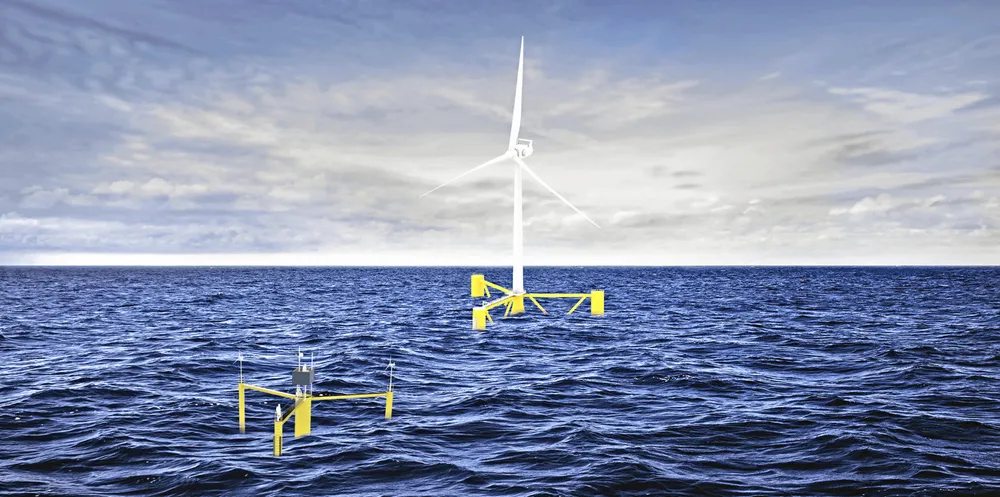'Rapid innovation': Oil giant Chevron backs new floating wind design for US Atlantic debut
Supermajor joins Norwegian industrialist Moreld in funding Ocergy concept, with 10MW prototype in line for Shell-Ocean Winds Mayflower wind project off Massachusetts

US international oil company Chevron has joined European peers Shell, Total and Equinor in throwing its weight behind the industrialisation of the floating wind power sector, with the supermajor partnering with Norwegian industrial group Moreld to prototype a new design from technology developer Ocergy that is in the frame for installation in the Atlantic by 2025.
Green is the new black. Subscribe to Accelerate
Get the market insight you need into the global oil & gas industry's energy transition – from the new newsletter from Upstream and Recharge. Sign up here
Chevron, the first American oil player to announce plans to invest in floating wind as part of a longer-term energy transition strategy, will finance its side via the $100m Future Energy Fund (FEF) set up under its Chevron Technology Ventures (CTV) arm.
Moreld, owner of a number of companies operating in the offshore wind space including contractor Global Maritime and moorings specialist Vryhof, is being underwritten by its parent company, Stavanger-headquartered energy sector capital investment house HitecVision.
“Offshore wind power is undergoing a period of rapid innovation in an effort to provide lower-carbon energy at a substantial scale,” said Barbara Burger, Chevron’s vice president of innovation and president of CTV.
“Ocergy has developed technology that could be part of the solution to enable more affordable, reliable, and ever-cleaner energy in a marine environment.”
Ocergy’s OCG-Wind concept, Burger noted, was a clear fit for the company’s FEF, which has just moved forward on its second pot, valued at $300m: “The scope of the Future Energy Fund… starts with the future energy system and it looks at the innovative technologies that are likely to play a key role.”
“If [the design] is successful, if it scales as the market for offshore wind comes online those all come together to potentially capture an attractive segment in the future energy system. We invest long before things are in the money.”
Geir Austigard, CEO of Moreld, which has formed EPCI (engineering, procurement, construction, and installation) spin-off Moreld Offshore Wind (MOW) in time with the Ocergy investment, sees the addition of floating wind to its portfolio rounding out a “full set of competences” for the coming offshore market boom.
“Global Maritime has a wide experience in the planning and execution of marine services, including floating wind. Vryhof has edge technology for safe station-keeping through anchoring solutions for several of the already installed offshore wind installations globally. Origo has developed new control systems for floating wind farms. Apply is a key contributor to MOW combining offshore project execution models with in-house engineering skills,” he said.
“By adding Ocergy and offshore wind veterans to the portfolio, we will have the full set of competences, technology and execution models in-house.
Ocery CEO Dominique Roddier stated: “With MOW onboard we gain a trusted partner who will be able to provide an EPCI solution for [our design], a key requirement for many of our clients. We are excited to have gained Chevron’s investment, and look forward to potential opportunities for their guidance and expertise executing some of the most complex offshore projects in the world.”
Modularisation in the making
By its calculations, a 10MW unit based on the Ocergy platform concept could generate power at a levelised cost of energy (LCOE) as low as $50/MWh from “large wind farms with good wind resource and favourable environmental conditions” – an LCOE that would bring floating down to a level on par with conventional fixed-foundation offshore wind.
“The Ocergy floating foundation is tailored to existing infrastructure, to minimise the requirement for large investments that would be detrimental to LCOE and would jeopardise project schedule”.
Along with the OCG-Wind floating platform, Ocergy has also developed a supporting environmental monitoring buoy called OCG-Data, an offshore site assessment unit that collects wind and metocean readings, and features sensor arrays to monitor underwater biodiversity as well as a bird and bat detection and identification system.
Following testing at the site – located in waters widely suited to fixed foundations but where depths drop off down to 65 metres, necessitating floating turbines – the aim is to shift up the gears quickly for a pipeline of utility-scale arrays off Europe and the US west coast before expanding to include the emerging play off Asia.
Austigard believes Moreld’s investment “positions Ocergy as a potential leader in advancing floating wind to successfully compete for gigawatt-scale commercial projects… worldwide”.
“The ability to develop a strong floating wind enterprise combined with a strong knowledge in the future energy business represents a significant added value for our customers and for the owners.
“Our playing field [will be] global. But in the short run, [our] primary attention will be directed towards the most progressed markets for floating wind in Europe: France, Scotland, UK, Spain, Portugal... and Norway,” said Austigard, noting that Ocergy had “a strong foothold” in US for first West Coast projects and that Asia-Pacific plays could be “next in line”.
“This decade we will see many new markets maturing,” he added.
“We are not going to have an on-purpose renewable power business within Chevron but we also see intersections between something like offshore wind potentially with green hydrogen [and the company’s core oil & gas business].
“At this point, we are focused on delivering higher returns and lower carbon with action to lower carbon intensity cost efficiently, increase renewables and offsets in support of our business, and invest in low-carbon technologies.”